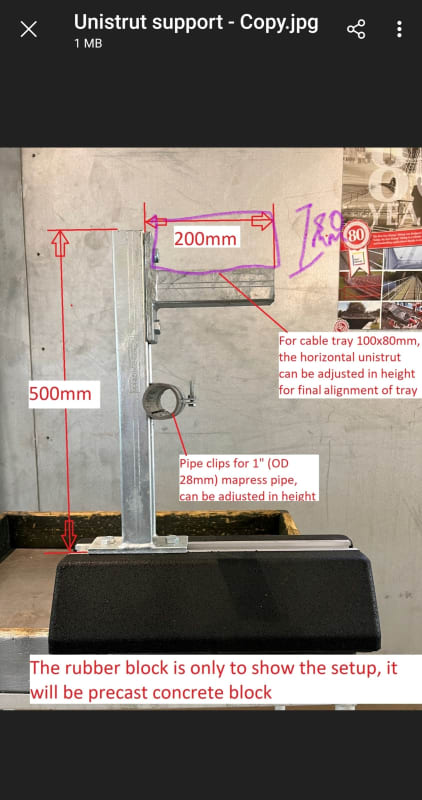Redacted
Structural
- Mar 12, 2016
- 160
Hi there,
I have a project where a client has a single 1”(28mm OD) pipe that they would like to mount along with a 80mm high cable tray on top. See below image:

The client would like to use a precast solution to hold the pipe down and were initially looking at using some parking bumpers to anchor into and use as dead weight. These bumpers are concrete and are 30” (0.762m) long by 8” (0.203m) wide and 5”(0.127m) deep. They wanted to have these spaced at 2m and for this to be checked to see if it is adequate for hurricane force winds (150mph).
According to the ASCE 7-10 factors, the 150mph translates to 2kPa of wind pressure.
I used the “Wind Loads for Petrochemical and other Industrial Facilities” ASCE document as guidance for this.
The document recommends a simple formula of F=qz*G*Cf*A
Where A is the tributary area of the length multiplied by the height of the pipe or cable tray.
qz is the velocity pressure
G is the gust factor (taken as 1)
Cf is the force coefficient which the document specifies should be 0.7 for pipes and 2 for cable tray.
I would like to make sure that I am not being too conservative here as the pipe will only be around .25m above the foundation and the cable tray only around 0.5m above the foundation.
Some quick hand calcs are showing me that for a 2m spacing.
Wind force acting on the pipe = 2x1x0.7x0.56 = 0.0784kN
Wind force acting on the cable tray = 2x1x2x0.16 = 0.64kN
So total sliding force is 0.7184 kN.
Total moment acting on base is ~0.454kNm.
According to these loads, the original parking bumper dimensions are not adequate to resist sliding.
A 36” long, 8” deep and 16” wide concrete block seems to be sufficient instead.
So :
Question 1. For a structure like this where they primarily will just be using it as a block of deadweight to stop the pipe system from sliding or uplifting, does it need to have minimum reinforcement? Or can it be seen as a mass concrete block?
Question 2. If the 150mph wind is the design wind load, would I then need to go ahead and apply the standard sliding safety factor of 1.5 as well? Or would it be reasonable to use the 150mph design wind speed and have a safety factor of 1?
Question 3. It appears to me that the sliding will govern but is there anything else that I should be checking for in a system like this?
I have a project where a client has a single 1”(28mm OD) pipe that they would like to mount along with a 80mm high cable tray on top. See below image:

The client would like to use a precast solution to hold the pipe down and were initially looking at using some parking bumpers to anchor into and use as dead weight. These bumpers are concrete and are 30” (0.762m) long by 8” (0.203m) wide and 5”(0.127m) deep. They wanted to have these spaced at 2m and for this to be checked to see if it is adequate for hurricane force winds (150mph).
According to the ASCE 7-10 factors, the 150mph translates to 2kPa of wind pressure.
I used the “Wind Loads for Petrochemical and other Industrial Facilities” ASCE document as guidance for this.
The document recommends a simple formula of F=qz*G*Cf*A
Where A is the tributary area of the length multiplied by the height of the pipe or cable tray.
qz is the velocity pressure
G is the gust factor (taken as 1)
Cf is the force coefficient which the document specifies should be 0.7 for pipes and 2 for cable tray.
I would like to make sure that I am not being too conservative here as the pipe will only be around .25m above the foundation and the cable tray only around 0.5m above the foundation.
Some quick hand calcs are showing me that for a 2m spacing.
Wind force acting on the pipe = 2x1x0.7x0.56 = 0.0784kN
Wind force acting on the cable tray = 2x1x2x0.16 = 0.64kN
So total sliding force is 0.7184 kN.
Total moment acting on base is ~0.454kNm.
According to these loads, the original parking bumper dimensions are not adequate to resist sliding.
A 36” long, 8” deep and 16” wide concrete block seems to be sufficient instead.
So :
Question 1. For a structure like this where they primarily will just be using it as a block of deadweight to stop the pipe system from sliding or uplifting, does it need to have minimum reinforcement? Or can it be seen as a mass concrete block?
Question 2. If the 150mph wind is the design wind load, would I then need to go ahead and apply the standard sliding safety factor of 1.5 as well? Or would it be reasonable to use the 150mph design wind speed and have a safety factor of 1?
Question 3. It appears to me that the sliding will govern but is there anything else that I should be checking for in a system like this?
